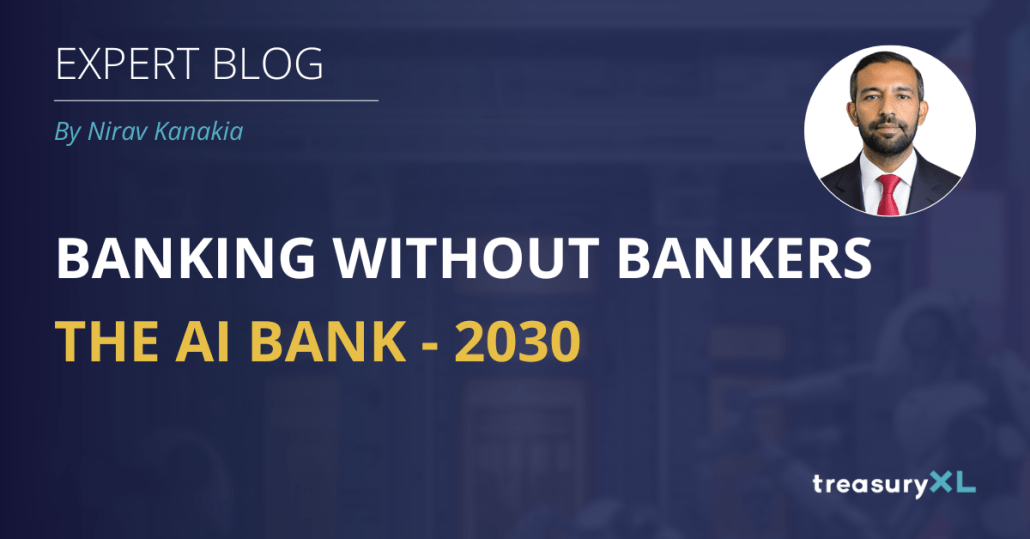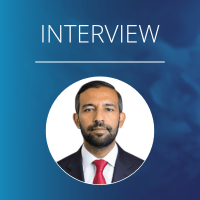Banking Without Bankers: The AI Bank – 2030
By Nirav Kanakia
Is banking industry going to be disrupted ? Will there be AI bank(s) or Banks enabled by AI in 2030.

“By 2030 – there will be no drivers and no teachers”. Vinod Khosla
In Early 2025, Vinod Khosla boldly predicted that by 2030, autonomous systems would render drivers and teachers obsolete.
I believe by 2030, there will be no bankers. _ spoke about this at length at- iima conf , got some push back. 🙂
Global finance is changing , the banking sector stands at a critical juncture. Traditional banking models, reliant on human-centric processes and legacy systems, are increasingly strained by the demands of modern consumers and the complexities of an ever-shifting regulatory environment. As we approach 2030, it is imperative to reimagine banking not as a labor-intensive operation but as a sophisticated, technology-driven protocol—a seamless integration of decision-making, risk management, and compliance best executed by advanced systems.
Banking, at its core, is a discipline of rules, data-driven decisions, and risk assessments—areas where machines consistently outperform humans in speed, accuracy, and scalability.
The Current State and Imperative for Change
The banking industry today faces multifaceted challenges that demand a paradigm shift:
- Regulatory Compliance: The regulatory landscape grows increasingly intricate, with heightened requirements for anti-money laundering (AML), know your customer (KYC), and data protection. Compliance costs are escalating, and human error remains a persistent vulnerability.
- Operational Efficiencies and Speed: Manual processes hinder transaction processing, loan approvals, and customer service, introducing delays and inefficiencies that modern consumers no longer tolerate.
- Risk Mitigation: In an era marked by cyber threats and financial volatility, traditional risk management approaches fall short. Banks require real-time, data-driven insights to proactively address risks.
- Evolving Customer Expectations: Today’s clients demand instant, seamless, and personalized financial services—expectations that legacy systems struggle to meet.
These pressures highlight the urgent need for automation. Technologies such as blockchain, artificial intelligence (AI), and advanced algorithms are not futuristic ideals but practical tools already reshaping the financial sector.
A Glimpse into the Future
At its core, a bank is a composition of processes—compliance checks, product delivery, operational tasks, fraud detection, KYC/AML/sanctions screening, and more. Today, these are siloed, legacy-bound, and reactive.
We reimagine this by treating each of these functions as AI agents capable of autonomous decision-making, learning, and collaboration. These agents are orchestrated dynamically, contextually, and intelligently, just like a well-run team
At its essence, a bank is a collection of processes—compliance checks, product delivery, fraud detection, KYC/AML/sanctions screening, and more. Today, these functions are siloed, slowed by legacy systems, and reactive. We envision a radical transformation: each process as an autonomous AI agent, capable of real-time decision-making, learning, and collaboration. These agents operate dynamically and contextually, orchestrated like a high-performing team to deliver secure, efficient, and compliant financial services.
Do you agree? What do you think the bank of the future should be?
Can’t get enough? Check out these latest items
 https://treasuryxl.com/wp-content/uploads/2025/06/Nirav-Interview-1.png
200
200
treasuryXL
https://treasuryxl.com/wp-content/uploads/2018/07/treasuryXL-logo-300x56.png
treasuryXL2025-12-16 07:00:212025-12-15 12:30:31Stablecoins: The Silent Revolution Is Already Here
https://treasuryxl.com/wp-content/uploads/2025/06/Nirav-Interview-1.png
200
200
treasuryXL
https://treasuryxl.com/wp-content/uploads/2018/07/treasuryXL-logo-300x56.png
treasuryXL2025-12-16 07:00:212025-12-15 12:30:31Stablecoins: The Silent Revolution Is Already Here https://treasuryxl.com/wp-content/uploads/2025/06/Nirav-Interview-1.png
200
200
treasuryXL
https://treasuryxl.com/wp-content/uploads/2018/07/treasuryXL-logo-300x56.png
treasuryXL2025-11-18 07:00:072025-11-28 14:33:19Future of Fintech Report – ai video
https://treasuryxl.com/wp-content/uploads/2025/06/Nirav-Interview-1.png
200
200
treasuryXL
https://treasuryxl.com/wp-content/uploads/2018/07/treasuryXL-logo-300x56.png
treasuryXL2025-11-18 07:00:072025-11-28 14:33:19Future of Fintech Report – ai video https://treasuryxl.com/wp-content/uploads/2025/06/Nirav-Interview-1.png
200
200
treasuryXL
https://treasuryxl.com/wp-content/uploads/2018/07/treasuryXL-logo-300x56.png
treasuryXL2025-11-05 07:00:482025-11-12 15:38:28Treasury in the Age of Fintech: Insights from Money 20/20
https://treasuryxl.com/wp-content/uploads/2025/06/Nirav-Interview-1.png
200
200
treasuryXL
https://treasuryxl.com/wp-content/uploads/2018/07/treasuryXL-logo-300x56.png
treasuryXL2025-11-05 07:00:482025-11-12 15:38:28Treasury in the Age of Fintech: Insights from Money 20/20 https://treasuryxl.com/wp-content/uploads/2025/06/Nirav-Interview-1.png
200
200
treasuryXL
https://treasuryxl.com/wp-content/uploads/2018/07/treasuryXL-logo-300x56.png
treasuryXL2025-07-30 08:41:272025-07-30 08:41:27GENIUS Act Signed – Stablecoins Get Clarity! (pun intended)
https://treasuryxl.com/wp-content/uploads/2025/06/Nirav-Interview-1.png
200
200
treasuryXL
https://treasuryxl.com/wp-content/uploads/2018/07/treasuryXL-logo-300x56.png
treasuryXL2025-07-30 08:41:272025-07-30 08:41:27GENIUS Act Signed – Stablecoins Get Clarity! (pun intended) https://treasuryxl.com/wp-content/uploads/2025/06/Nirav-Interview-1.png
200
200
treasuryXL
https://treasuryxl.com/wp-content/uploads/2018/07/treasuryXL-logo-300x56.png
treasuryXL2025-07-23 07:00:062025-07-22 10:00:54AI vs. Stablecoins: Treasurers’ Surprising (is it) Verdict
https://treasuryxl.com/wp-content/uploads/2025/06/Nirav-Interview-1.png
200
200
treasuryXL
https://treasuryxl.com/wp-content/uploads/2018/07/treasuryXL-logo-300x56.png
treasuryXL2025-07-23 07:00:062025-07-22 10:00:54AI vs. Stablecoins: Treasurers’ Surprising (is it) Verdict https://treasuryxl.com/wp-content/uploads/2025/06/Nirav-Interview-1.png
200
200
treasuryXL
https://treasuryxl.com/wp-content/uploads/2018/07/treasuryXL-logo-300x56.png
treasuryXL2025-06-24 07:00:242025-06-23 10:59:38In House Bank – Your Money Works For You Under Your Watch
https://treasuryxl.com/wp-content/uploads/2025/06/Nirav-Interview-1.png
200
200
treasuryXL
https://treasuryxl.com/wp-content/uploads/2018/07/treasuryXL-logo-300x56.png
treasuryXL2025-06-24 07:00:242025-06-23 10:59:38In House Bank – Your Money Works For You Under Your Watch https://treasuryxl.com/wp-content/uploads/2025/06/Nirav-Interview-1.png
200
200
treasuryXL
https://treasuryxl.com/wp-content/uploads/2018/07/treasuryXL-logo-300x56.png
treasuryXL2025-06-10 07:00:552025-06-10 09:06:37Banking Without Bankers: The AI Bank – 2030
https://treasuryxl.com/wp-content/uploads/2025/06/Nirav-Interview-1.png
200
200
treasuryXL
https://treasuryxl.com/wp-content/uploads/2018/07/treasuryXL-logo-300x56.png
treasuryXL2025-06-10 07:00:552025-06-10 09:06:37Banking Without Bankers: The AI Bank – 2030 https://treasuryxl.com/wp-content/uploads/2025/05/Nirav-Interview.png
200
200
treasuryXL
https://treasuryxl.com/wp-content/uploads/2018/07/treasuryXL-logo-300x56.png
treasuryXL2025-05-06 07:00:342025-05-22 13:05:58Interview | Still Coding, Still Curious: Nirav’s Journey into Fintech and Treasury Tech
https://treasuryxl.com/wp-content/uploads/2025/05/Nirav-Interview.png
200
200
treasuryXL
https://treasuryxl.com/wp-content/uploads/2018/07/treasuryXL-logo-300x56.png
treasuryXL2025-05-06 07:00:342025-05-22 13:05:58Interview | Still Coding, Still Curious: Nirav’s Journey into Fintech and Treasury Tech


